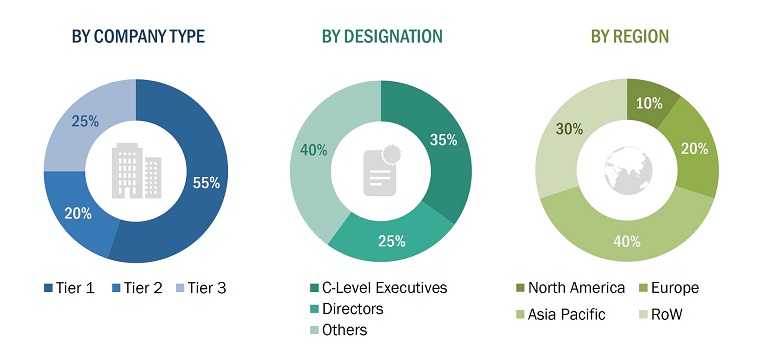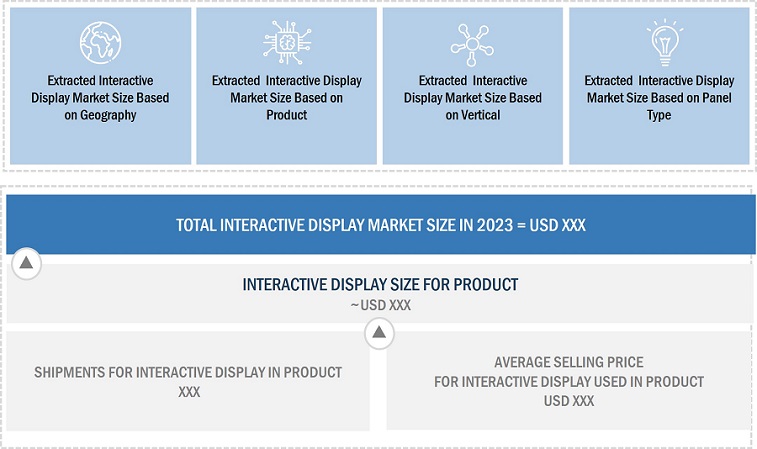The study involved four major activities in estimating the size of the interactive flat panel display market. Exhaustive secondary research has been conducted to collect information on the market, the peer markets, and the parent market. Both top-down and bottom-up approaches have been employed to estimate the total market size. Market breakdown and data triangulation methods have also been used to estimate the market for segments and subsegments.
Secondary Research
Revenues of companies offering interactive displays have been obtained from the secondary data available through paid and unpaid sources. The revenues have also been derived by analyzing the product portfolio of key companies, and these companies have been rated according to the performance and quality of their products.
Various secondary sources have been referred to in the secondary research process for identifying and collecting information important for this study. Secondary sources include corporate filings (such as annual reports, investor presentations, and financial statements); trade, business, and professional associations; white papers; IoT technologies journals and certified publications; articles by recognized authors; gold-standard and silver-standard websites; directories; and databases.
Secondary research has been conducted mainly to obtain critical information about the market’s value chain, the total pool of key players, market classification and segmentation according to the industry trends to the bottom-most level, geographic markets, and key developments from both demand- and technology-oriented perspectives. Secondary data has been collected and analyzed to determine the overall market size, further validated by primary research.
Primary Research
Extensive primary research has been conducted after understanding and analyzing the current scenario of the interactive flat panel display market through secondary research. Several primary interviews have been conducted with key opinion leaders from both demand and supply sides across 4 major regions: North America, Europe, Asia Pacific, and RoW. Approximately 25% of the primary interviews have been conducted on the demand side, while 75% have been conducted on the supply side. Primary data has been collected mainly through telephonic interviews, which consist of 80% of the total primary interviews. Questionnaires and e-mails have also been used to collect data.
After interacting with industry experts, brief sessions were conducted with highly experienced independent consultants to reinforce the findings from our primary. This, along with the in-house subject matter experts’ opinions, has led us to the findings as described in the remainder of this report. The breakdown of primary respondents is as follows:

To know about the assumptions considered for the study, download the pdf brochure
Market Size Estimation
The bottom-up procedure has been employed to arrive at the overall size of the interactive display market.
-
Identifying the entities in the interactive display market influencing the entire market along with related component players
-
Analyzing major manufacturers of interactive displays, studying their portfolios, and understanding different types of products based on their features and functions
-
Analyzing trends in the usage of interactive display offerings
-
Tracking the ongoing and upcoming developments in the market, such as investments made, R&D activities, product launches, collaborations, and partnerships, and forecasting the market size based on these developments and other critical parameters
-
Carrying out multiple discussions with key opinion leaders to understand the different types of interactive displays, applications, and recent trends in the market, thereby analyzing the breakup of the scope of work carried out by major manufacturing companies
-
Arriving at the market estimates by analyzing segmental revenues of these companies generated by interactive display offerings and then combining the same to get the market estimate by different segments
-
Verifying and cross-checking the estimate at every level by discussing with key opinion leaders, such as Chief Experience Officers (CXOs), directors, and operations managers, and finally with the domain experts at MarketsandMarkets
-
Studying various paid and unpaid sources of information, such as annual reports, press releases, white papers, Factiva, and databases

The top-down approach has been used to estimate and validate the total size of the interactive display market.
-
Focusing initially on the investments and expenditures being made in the ecosystems of various applications
-
Calculate the market size, considering revenues generated by major players through the cost of the interactive display.
-
Segmenting each application of interactive display in each region and deriving the global market size based on region.
-
Acquiring and analyzing information related to revenues generated by players through their key offerings.
-
Conducting multiple on-field discussions with key opinion leaders involved in the development of various interactive display offerings.
-
Estimating the geographic split using secondary sources based on various factors, such as the number of players in a specific country and region and the types of interactive display used in education, transportation, retail and hospitality, corporate and government, industrial, and healthcare.

Data Triangulation
After arriving at the overall size of the interactive display market through the process explained, the total market has been split into several segments and subsegments. Market breakdown and data triangulation procedures have been employed, wherever applicable, to complete the overall market engineering process and arrive at the exact statistics for all segments and subsegments. The data has been triangulated by studying various factors and trends from the demand and supply sides. The market has also been validated using the top-down and bottom-up approaches.
Market Definition
An interactive display is a display that can accept input using touch. It is designed to provide customers access to information such as wayfinding, self-check-in, product availability at a departmental store, patient details, and others. These displays have specially designed software applications for creating an interactive experience while delivering information based on the input received from end users. Thus, interactive displays act as dynamic information-sharing devices in sectors such as retail, transportation, healthcare, and educational institutes.
Key Stakeholders
-
Raw material suppliers
-
Original equipment manufacturers (OEMs)
-
OEM technology providers
-
Original design manufacturers (ODMs)
-
Technology, service, and solution providers
-
Suppliers and distributors
-
Government and other regulatory bodies
-
Forums, alliances, and associations
-
Technology investors
-
Research institutes and organizations
-
Analysts and strategic business planners
-
Market research and consulting firms
Report Objectives
-
To define, describe, segment, and forecast the global interactive display market in terms of value on the basis of panel size, panel type, technology, vertical, and region
-
To define, describe, segment, and forecast the global interactive display market in terms of value and volume based on product.
-
To describe and forecast the market size, in terms of value, with respect to four major regions: North America, Europe, Asia Pacific (APAC), and the Rest of the World (RoW)
-
To provide detailed information regarding the major factors influencing the growth of the market (drivers, restraints, opportunities, and challenges)
-
To provide a detailed value chain for the interactive display industry and analyze the market trends
-
To strategically analyze the micromarkets1 with respect to individual growth trends, prospects, and contributions to the total market
-
To highlight the impact of Porter's five forces on the interactive display market ecosystem and analyze the underlying market opportunities
-
To analyze the associated case studies in the interactive display market business and their impact on the business strategies adopted by key players
-
To analyze the opportunities for stakeholders in the market and detail the competitive landscape of the market leaders
-
To provide key industry trends and associated important regulations impacting the global interactive display market
-
To strategically profile the key players and comprehensively analyze their market shares and core competencies
-
To benchmark players within the market using the proprietary company evaluation matrix framework, which analyzes market players on various parameters within the broad categories of market rank and product offering
-
To analyze the competitive strategies, such as contracts, joint ventures, and acquisitions, product launches and developments, and research and developments, adopted by the interactive display market players
-
To map the competitive intelligence on the basis of company profiles, key player strategies, and game-changing developments, such as contracts, product launches, collaborations, and acquisitions.
Available customizations:
With the given market data, MarketsandMarkets offers customizations according to the specific requirements of companies. The following customization options are available for the report:
-
Detailed analysis and profiling of additional market players based on various blocks of the supply chain

/mc
Nov, 2020
How does the Covid-19 epidemic impact this market.